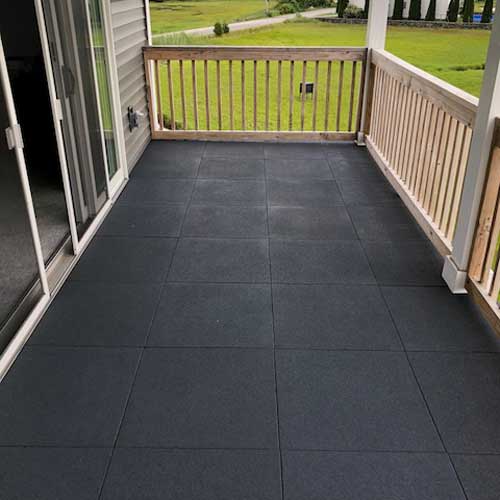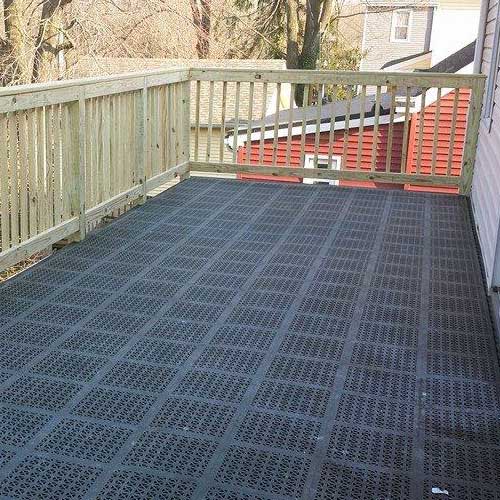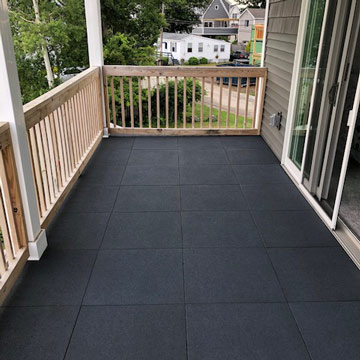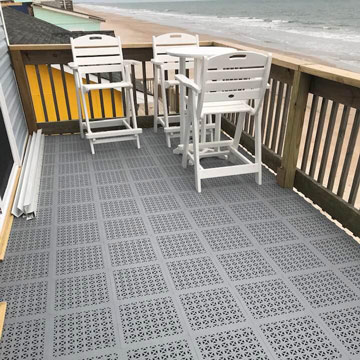Can You Install Rubber Tiles Over a Wood Deck?
Related Product: Sterling Roof Top Tile Solid Colors 2 Inch x 2x2 Ft.
There are a few specific types of rubber tiles over wood deck designs that will work especially well without causing damage over the long term to the wood decking.
- Solid surface tiles: Solid surface rubber tiles provide a durable, long-lasting surface that feels comfortable underfoot and increases traction. Many rubber deck tiles require adhesive to install. The tiles are very heavy weighing up to 30 pounds each. These work better than having to paint the deck every year too. Some rubber tiles designed to be used over wood deck products have channels in the design on the underside to allow water to flow away.
- Perforated tiles: To drain away heavy rain and other water as quickly as possible, a perforated design is ideal. The holes in the tiles run through the entire thickness, so water drains to the wood decking surface under the tile, where it can flow away. This type of design often consists of a flexible rubber-like PVC blend that gives a feel similar to rubber. This is a good design for ensuring that a little bit of air will flow underneath the tiles, which helps moisture to evaporate before it becomes a problem.
If using rubber tiles over wood deck products with the idea of having water flow underneath the tiles and away from the deck, make sure the deck material over which the installation is occurring has a slight slant or grade to it. With a completely flat deck, the water will collect, rather than flowing away.
What Are Some of the Best Rubber Tiles that Allow Water Flow?
If seeking the most durable type of rubber tiles over wood deck models, outdoor rubber tiles are the best selection. Rubber is extremely durable and will provide a long-lasting material that gives a good value. Rubber can hold up to the use of furniture on the deck, creating a sturdy floor.The Sterling Roof Top Tile has a design that customers often install on roofs, which shows the type of durability these offer. Each tile measures 2 inches in thickness, giving it the ability to handle people walking on it and heavy furniture being placed on it.
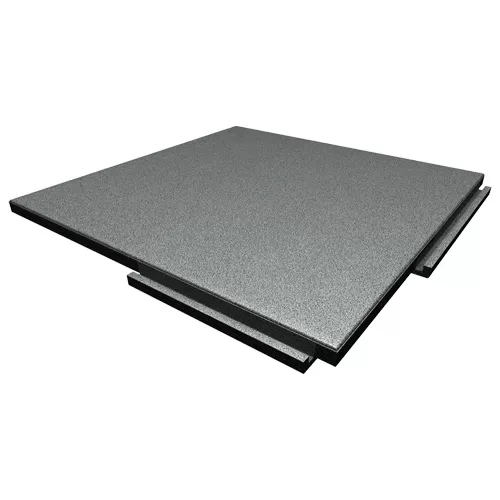
It has a size of 2-by-2 feet, which speeds up the layout, even when running these rubber tiles over wood deck surfaces that are especially large. Glue the interlocking tab attachment on one tile to the tab on the adjacent tile to ensure a secure connection.
Another option is the Blue Sky Outdoor Interlocking Tile. It also has a 2-by-2 foot size that allows the layout to go fast. It delivers a little more thickness than the Sterling product at 2.25 inches, allowing it to carry a 4-foot fall height rating.

Both of these rubber tiles use a series of channels carved into the underside of the tiles, which means that rainwater will drain underneath the tiles across the wood surface of the deck. By allowing the water to move under the tiles through the channels, it will not pool on the wood surface, which could eventually lead to damage.
Do Perforated Tiles Have Stability Problems?
Our perforated tiles for use over decks have a precise perforated design that does not compromise the stability and durability of the unit.The StayLock Perforated Tile consists of a PVC plastic material that’s flexible and durable, yielding many of the same benefits as an all-rubber tile. It also looks a lot like rubber with an all-black color option, but it weighs far less than rubber, which simplifies the installation process. Be aware that the lightweight PVC material will not be able to support as heavy of furniture as the rubber material will. Lightweight furniture is just fine.

The perforations allow rainwater to drain through the tile and flow away, rather than pooling on the top of the tile or underneath the tile, creating the safest possible layout. If you suspect you’ll ever have the need to temporarily remove a portion of the flooring to inspect your deck, this is your best option.
